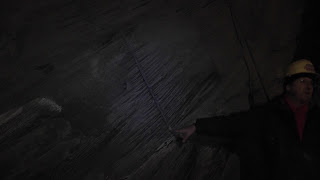In a nutshell
Gauge: 1' 11½"
Length: 800m (Tramway) 500' descent plus half mile walk (Deep Mine)
Opened: 1846 (Original quarry) 1972 (Miners' Tramway) 1979 (Deep Mine)
Location:
Llechwedd Slate Caverns
Blaenau Ffestiniog
Gwynedd LL41 3NB
View Larger Map
Email. bookings@llechwedd.co.uk
Date of visit: 20 February 2013
Key Facts
- The Llechwedd slate quarry was opened in 1846 by John Greaves. He later became the treasurer and eventually chairman of the Festiniog Railway.
- At its peak, the quarry had 513 employees and produced 23,788 tons of finished slate per year (1884)
- In 1890 the quarry machinery was converted to electrical power with the quarry's own hydro-electric generating station.
- In its heyday, slate was mined by hollowing out large galleries. A team of four men was responsible for extracting and finishing the slate from each gallery. Some galleries were up to 250' from floor to ceiling.
- Blocks of slate were transported from the galleries to the finishing sheds along horse-drawn tramways.
- Slate is still being extracted on the site by open-cast quarrying from the surface.
- The caverns now include two separate visitor attractions - the Miners' Tramway which uses a battery powered locomotive to haul visitors through a tunnel with two stops in galleries for illustrated talks - and the Deep Mine which involves descent via an incline with a guided walk through a series of galleries, some of which are now flooded.
My Impressions
I coincided this visit with a trip on the Ffestiniog Railway and only had time on this occasion to travel on the Miners' Tramway. I will return at some time in the future to complete the visit by touring the Deep Mine.As this was only a flying visit, I did not have time to sample the delights of the cafe though I did spend a while exploring the shop, which provides a selection of slate-related memorabilia and some literature relating to slate quarrying and the local community. At this time of the year, tours depart at half hourly intervals and so, after a short wait, our train reversed into the station and we boarded the coach for our trip into the mine.
I took my seat in the last carriage which gave me a view through the other coaches as the train wound its way through the twisting tunnels.
After passing a few floodlit galleries and side tunnels we stopped at the entrance to a gallery where we alighted and our guide explained the Victorian working practices for extracting slate.
We hopped aboard the train once more and wound our way through to another two galleries where we were entertained with an audio visual presentation of working practices and a further live talk, explaining some of the health and safety issues associated with life in the mines.
Meanwhile, our train had turned round via a reversing triangle and we resumed our seats for the return ride. We were then given a demonstration of slate-splitting in the finishing shed.................
............ before my fellow-passengers made their way to the Deep Mine. I will have to save this part of the tour for my next visit as we needed to travel back to Cheshire for an appointment.
The slate caverns are certainly impressive and if you have not already seen them, they are well worth a visit. The opportunity to see first-hand this reconstruction of an important part of North Wales' industrial heritage is both enlightening and salutary. The last time I visited the Caverns was 26 years ago when I accompanied a school party on a visit. It was reassuring to see that this tour was very much as it was then. It would seem that the winning formula from the early days of this visitor attraction has been retained. I am looking forward to my next visit when I will be able to relive my experiences in the Deep Mine.
Video
[In preparation]





No comments:
Post a Comment